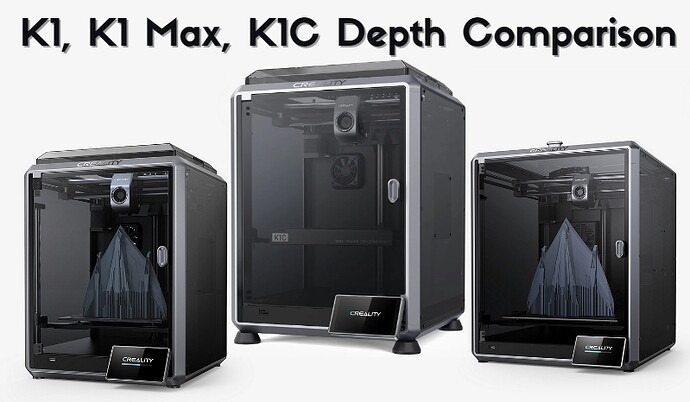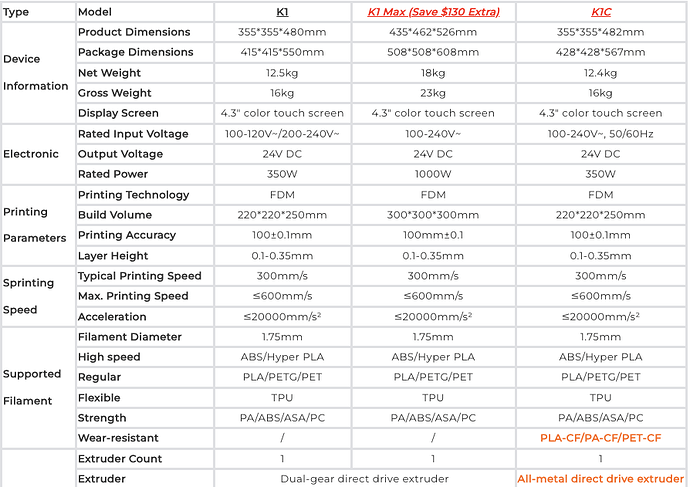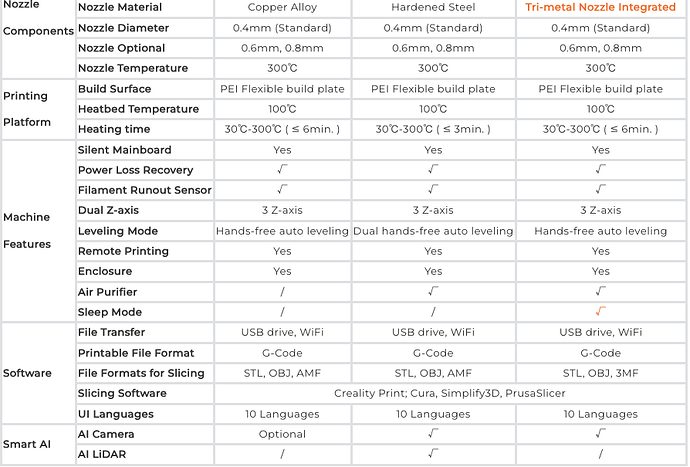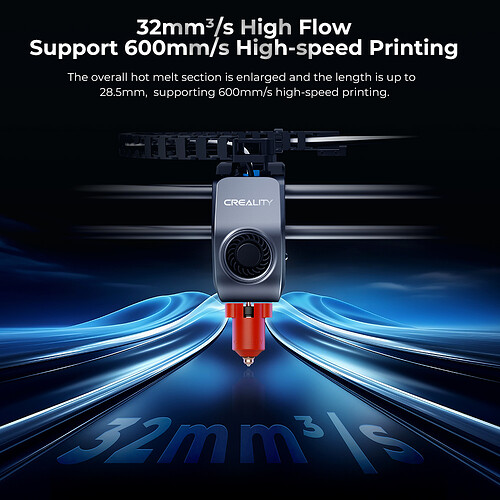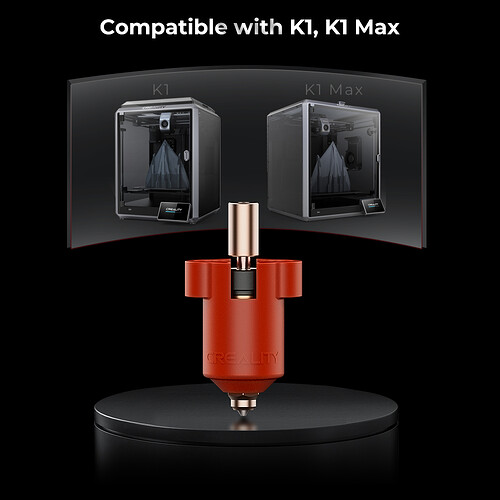Creality introduced its flagship products - the K1 and K1 Max in April 2023. Unlike the budget-friendly Ender 3 series, the K1 series stands out as a fully enclosed high-speed 3D printer with intelligent AI that excels in both speed and functionality. Significant advancements have been achieved in all aspects, leading to widespread love and popularity upon its release.
The K1C, as one of the latest flagship members, is scheduled to be released in 2024, with pre-sales starting on January 25. Dubbed the “Champion of Speed and Skill,” this model is designed specifically for carbon fiber 3D printing. While it shares many features with the K1 and K1 Max, there are also notable differences.
In this article, we aim to provide a comprehensive overview of all three models so that you can make an informed choice when selecting the 3D printer that best suits your needs.
- K1 Series Specifications at A Glance
- K1 Series Similarities Overview
- K1 Series Differences Detailed Comparison
- Which One is Right for You? K1, K1 Max or K1C?
Part1: K1/K1 Max/K1C Specification at A Glance
Let’s delve into the technical specifications of the K1, K1 Max, and K1C, covering essential machine details, printing parameters, printing speed, filament support, printer features and more.
Part2: Similarities Overview: K1 vs. K1 Max vs. K1C
Let’s begin by noting the commonalities among the Creality K1, K1 Max, and K1C printers. The first similarity is that all three printers come almost fully assembled. Setting them up takes just around 20 minutes. After assembly, the touchscreen helps you start automatic calibration and self-testing to check the hardware for issues. If everything’s okay, you’ll get a prompt to begin your first print.
1. Printing Speed
One notable shared feature is the CoreXY design, enhancing motor precision, compacting the machine, and enabling impressive print speeds of up to 600 mm/s with accelerations reaching 20,000 mm/s².
2. Build Plate
The K1, K1 Max, and K1C feature a heated aluminum alloy bed for fast and even heating. The build plate is a flexible smooth PEI sheet, ensures good adhesion for small and large prints. Occasionally, applying glue may enhance adhesion. The enclosed system allows easy printing of high-temperature filaments like ABS and ASA.
3. UI Design
The printer includes a user-friendly 4.3-inch color touchscreen for previewing loaded models. It comes with a modified Klipper version tuned for Creality printers. An update by Creality lets users enjoy Klipper’s benefits, like custom optimization profiles and joining the open-source community for exploring advanced features.
4. Software
The Creality K1, K1 Max, and K1C printers are supported by the official Creality Print slicing software. Additionally, they are compatible with popular 3D printing software such as Cura, Simplify3D, PrusaSlicer, and others. This flexibility allows users to choose the slicing software that best suits their preferences and workflow.
Part3: K1 vs. K1 Max vs. K1C Differences Details Comparison
However, there are some notable differences between the K1, K1 Max and K1C. Let’s take a look at the differences.
1. Build Volume
When it comes to build volume, as the name suggests, the Creality K1 Max stands out with its significantly larger space—measuring 300 x 300 x 300 mm. This substantial size allows users to print large models without the need for separation and later assembly. In contrast, both the K1 and K1C share the same build volume as the standard Ender 3, measuring at 220 x 220 x 250 mm.
2. Rated Power & Mainboard
The K1 Max boasts a robust 1000W rating, significantly higher than the 350W of the K1 and K1C. This higher power capacity allows users to easily upgrade and draw power from the motherboard. Compared to the K1 and K1C, the K1 Max achieves a temperature of 60℃ in just 90 seconds and maintains consistent heating speeds under both 220V and 110V. This power capacity also allows for direct powering of add-ons from the K1 Max motherboard, including the Creality multi-material system currently in development.
3. Filament Support
Both the K1 and K1 Max support a range of filaments, including PLA, Hyper PLA, PETG, ABS, TPU, and PA. The K1C, as indicated by the “C” in its name, stands for “Carbon” and introduces support for wear-resistant filaments like PLA-CF, PA-CF, and PET-CF, offering more filament options. This allows makers to explore and practice 3D scenes with greater versatility.
Moreover, the K1C features an all-metal integrated design for its nozzle and throat. Compared to the K1, this design ensures smoother material discharge, a longer service life, and effortless maintenance. The all-metal proximal extruder is further evolved, providing stable extrusion force and precise control over consumable flow to ensure high-quality model printing.
4. Smart AI Assistance
The K1, K1 Max, and K1C all incorporate intelligent AI functions, while with differing configurations. For instance, the K1’s Smart AI camera is available as an optional through accessory upgrades, while the K1C includes the AI camera as a standard feature. The K1 Max stands out by offering both “AI LiDAR” and “AI Camera,” making it the most advanced in terms of product function configuration.
In the case of the K1 Max, AI-assisted features contribute to enhanced print quality and a reduced likelihood of print failures, leading to savings on filaments. The LiDAR sensors map the first layer, ensuring a strong start with good adhesion and aiding in flow calibration. Additionally, the integrated AI-assisted camera monitors prints, detects failures, and captures time-lapse photography.
5. Price
The K1 base model is priced at $499, while the K1C is available for pre-order at $559 (5% off, regular price is $599), and the advanced features of the K1 Max come with a price about $300 more. While these upgrades are considered conveniences, others notably enhance print quality and user safety. Let’s delve into the key enhancements.
Firstly, although the K1 comes with a ventilation fan, the K1 Max elevates it with the inclusion of a carbon air filter. Additionally, the K1 Max features a larger build volume 300 x 300 x 300 mm. Finally, the K1 Max has advanced AI assistance functions “AI LiDAR” and “AI Camera,” ensuring the success rate of printing. However, you have the option to enhance the configuration of the K1 by acquiring AI camera accessories, a more cost-effective choice compared to directly purchasing the K1 Max.
Part4: Which One is Right for You? K1, K1 Max, K1C?
Determining the better value for money among the K1, K1 Max, and K1C ultimately depends on your personal preferences and priorities.
If cost-effectiveness is your top priority, the K1 is the most affordable choice among the three, offering excellent printing speed and quality.
For those seeking to create large-size models and utilize advanced AI functions for hassle-free printing, the K1 Max is the ideal option. It encompasses all the impressive features of the K1 with additional upgrades, albeit at a relatively higher price.
If you’re interested in exploring model creation with carbon fiber filaments and prefer a relaxed and quiet printing environment, the K1C is a great option. It comes with upgraded materials for the nozzle and extruder, allowing for silent mode operation.
In summary, although the K1, K1 Max, and K1C have many similarities, it’s important to recognize that the differences between them represent substantial upgrades, often considered as luxury features.
Conclusion
In conclusion, the Creality K1, K1 Max, and K1C are high-end 3D printers offering not only impressive printing speed but also exceptional print quality. Take action now and pick the right 3D printer that aligns with your specific needs and preferences.
Read more if you are interested in:
